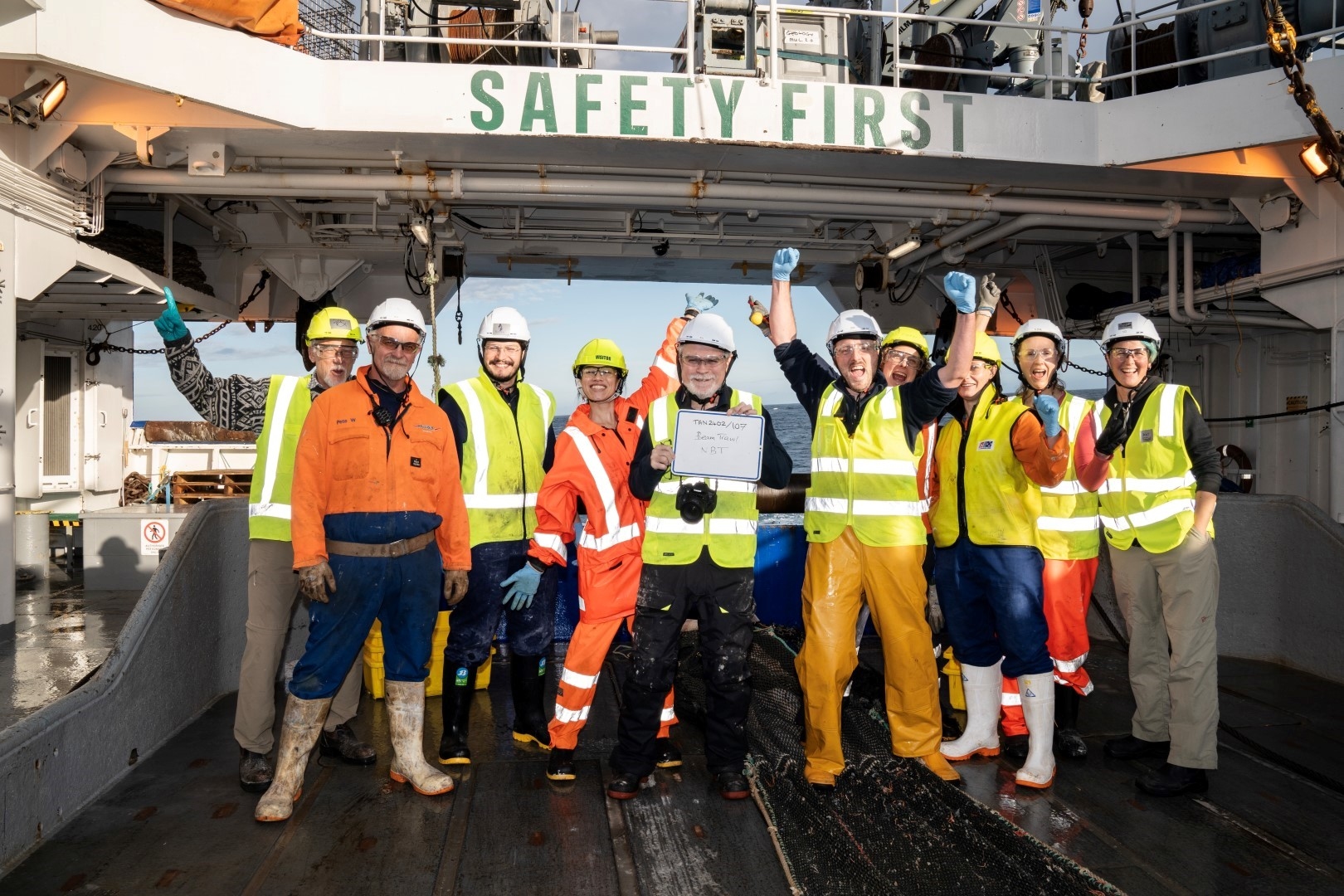Bounty Trough - voyage update #3
Here is the third and final update from Voyage leader, Sadie Mills on the 21-day Ocean Census – Bounty Trough research voyage.
We have amazing things to share. The Bounty Trough is living up to its name with an abundance of marine life! Things that are rare, unknown and even bizarre. We have even been down as deep as 4800 metres now, our deepest point.
Over 1700 samples collected by the end of our 21-day journey. A great result that has many of us still pinching ourselves.
My gratitude goes to everyone onboard, including the two shifts which allow us to work 24/7, led by my colleagues Daniel Leduc and Kareen Schnabel, who ensure our time at sea is maximised. While one shift sleeps, the other wakes and takes over into the night. They have both been very busy investigating the deep ocean.
We hope you enjoy learning about what we have found as much as we did.
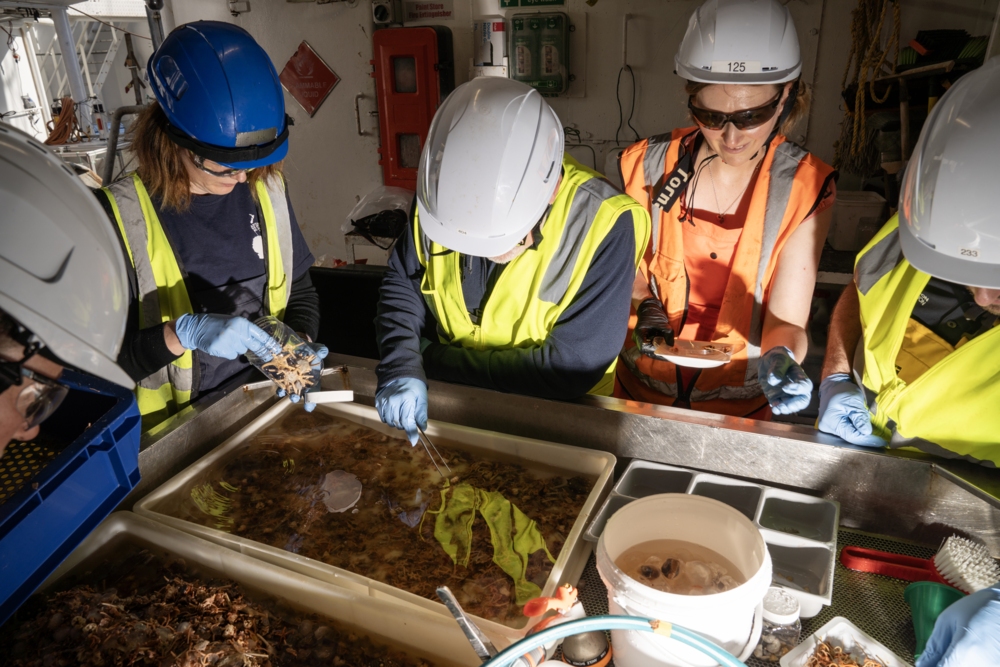
Reaching out across oceans (February 15)
In the early hours of the morning, the night shift completed two seamount sleds across the summit of another seamount. Highlights included a large gorgonian coral base (which can be used for coral aging projects) and a diverse catch of black coral, octocorals, galatheids, ophiuroids, pycnogonids and urchins.
Next was an exploration of the outside of the channel. Our underwater camera saw stalked sponges, anemones, cerianthids (tube anemones), holothurians, and giant foraminiferans. Other less common fauna included asteroids, gastropods, Kophobelemnon sea pens, ascidians, rattails and other bony fish.
The multicores successfully collected 8 tubes of mud, and the Brenke sled and beam trawl came back with some interesting finds. This included some giant salps. They are important creatures as they graze on tiny phytoplankton. Our colleague Svenja Halfter, a NIWA Zooplankton Ecologist has a special interest in them, so we wanted to see if she wanted some samples. Unfortunately, she is oceans away in the Ross Sea on the RV Laura Bassi. We decided to send a message anyway and see if she called back. She got back to us straight away (the miracle of Starlink) asking us to save some specimens frozen and in formalin for her. The Starlink connection on both vessels has really changed life at sea for us. Being able to connect with a colleague in real-time on a vessel in the Antarctic from another vessel off New Zealand is something that would not have been possible before. This also helps us to stay in good contact with home.
We collected a specimen of Corallimorphus, a strange anemone-like relation to cup corals that doesn’t have a hard skeleton and has balls on the end of its short tentacles! It looks a lot like the species Corallimorphus niwa, which was first discovered on the Chatham Rise in 2007 and was described in 2011 and would be one of only 19 specimens recorded of this species. It is endemic to New Zealand, which means it only occurs in this region.
We had a birthday onboard. We threw a small party for our hard-working videographer, Rebekah Parsons-King, who is helping bring you the amazing visuals of this voyage. The galley prepared a special dessert plate for her birthday lunch while we sang happy birthday. We saw a pod of pilot whales, which was a nice birthday treat.
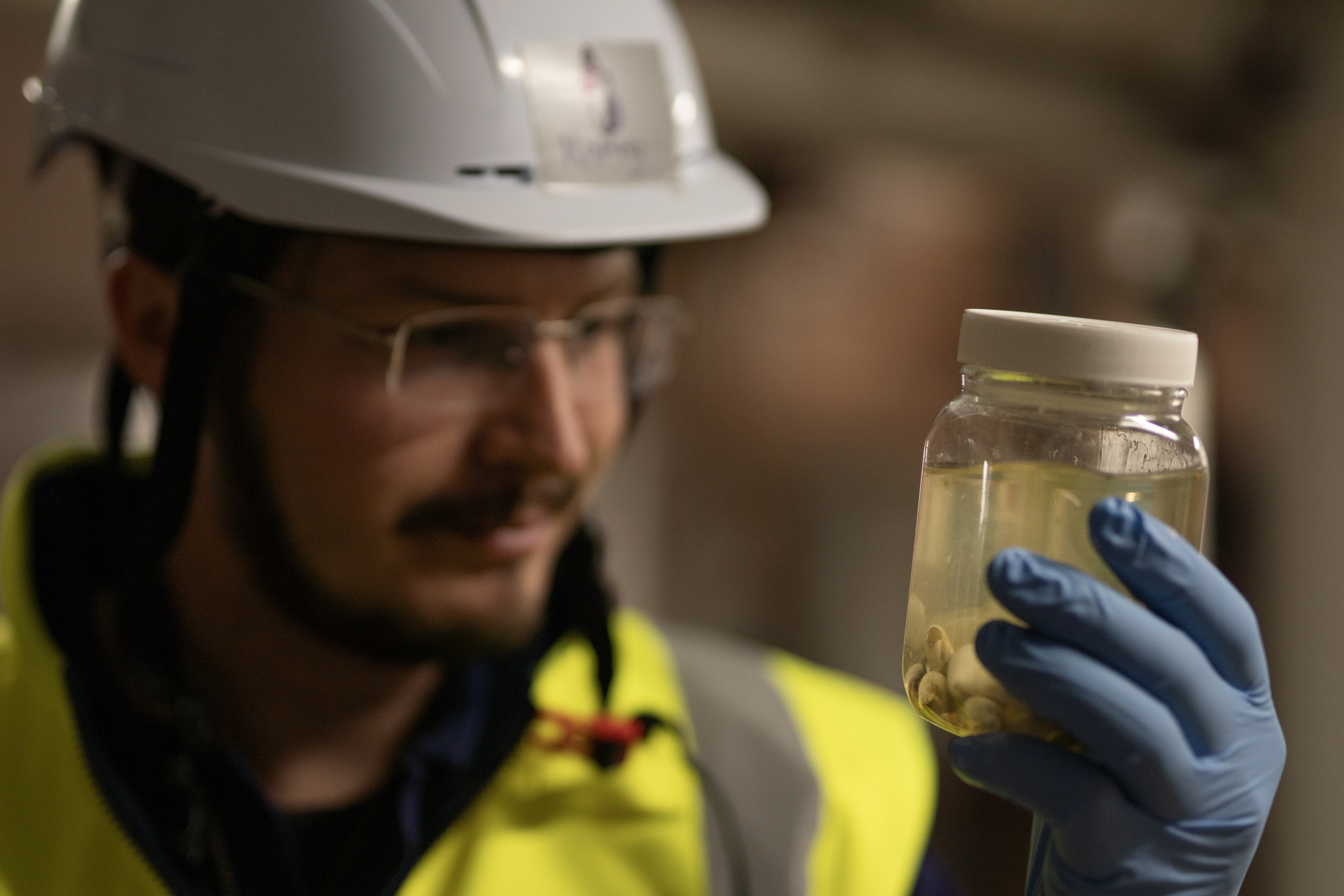
A seamount with a moat (February 16)
We arrived early in the morning and mapped around the 1250 metre peak of a very impressive seamount, which looked like it had a giant moat around it. Marine geologist, NIWA’s Alan Orpin explains why it’s so fascinating.
We deployed the fish trap on the top of it. While it didn’t return any fish, it held a nice squat lobster. Shift leader Kareen has a special interest in these squat lobsters and needs the data points for ongoing work on the distribution of these species. In her words, “squat lobsters have a special place in my heart since I have spent many years studying them and they can be beautifully coloured.”
Tomorrow we will arrive at our deepest site so far!
A very peculiar irregular urchin & a great day exploring the deep (February 17)
At 3000 metres we saw plenty of life to excite us about what else we might find in the deeper sites. There were abundant holothurians, some xenophyophores, ophiuroids, anemones/cerianthids, burrows, faecal coils (sea cucumber poo), hemichordate spirals, urchins, sea pens, asteroids, crinoid. The canyon wall was steep and rocky with gorgonian corals, lots of echinoids and xenophyophores. Lots of echinoids, holothurians, ophiuroids, eel, some crinoids and a cluster of brisingid seastars were seen on an isolated rock.
We were quick to get equipment out there to collect some of the amazing animals we were seeing. The beam trawl collected a couple of fish and a variety of interesting invertebrates including another rare white Munidopsis squat lobster, a Hymenaster sea star, a huge bristly sea spider, as well as lots of ophiuroids and sea cucumbers. Kerry Walton of Te Papa Tongarewa discovered some hairy limpets encrusting on some chunks of mudstone, which might be an unknown species.
In the Brenke sled there were lots of surprises, including a rare oddly shaped burrowing sea urchin. I think my co-leader Alex said it best, “A very peculiar irregular urchin”. As well as lots of molluscan treats for Kerry to investigate further and more ophiuroids and sea cucumbers, including some sea pigs in very nice condition! You might have seen the sea pigs on the Ocean Census Instagram.
Two fish were caught in the trap at 5pm collection! A Pachycara specimen, which was in beautiful condition and an eelpout, both likely new species. We were all very excited for the Te Papa team. An ophiuroid was also surprisingly caught in the trap and is a rare specimen of Ophiosphalma cf. armatum (a known yet undescribed NZ deepsea species).
This evening, we are still waiting for the sled to come up at around 9pm. We are going deeper now, so it takes an hour for the sled to get down to the bottom and an hour to come back up. It’s a lot of effort for the person running the winch and requires a lot of expertise to ensure things go smoothly, but we are excited about what we will find.
Today we are opportunistically putting a plankton net over into the surface waters while we wait for the sled to come up to see if we can catch some juvenile squid at dusk.
A great day exploring the deep!
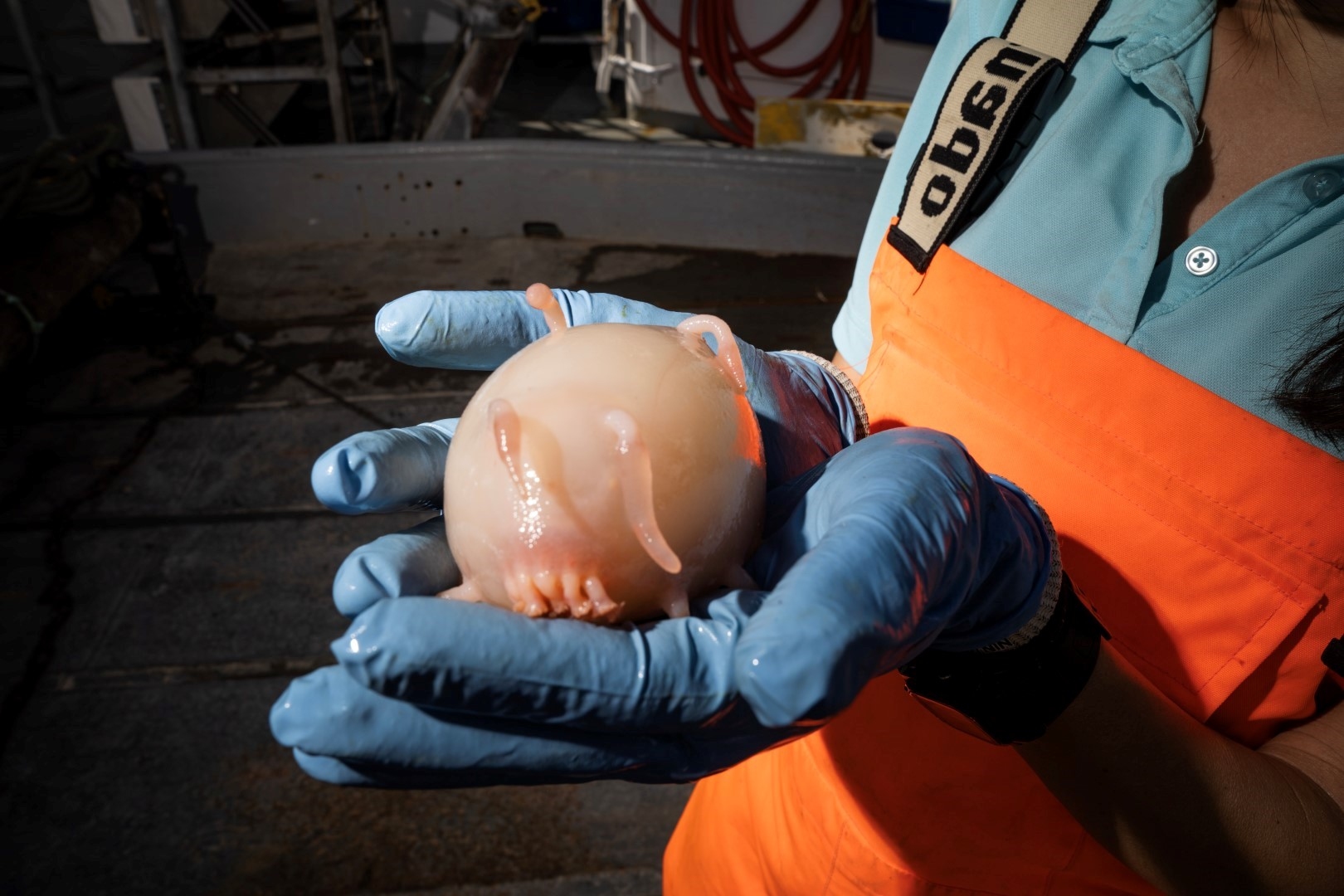
Diverse catch (18 February)
We sampled another non-channel site in the early hours of the morning. Sparse megafauna (large marine animals) were seen, including echinoids, holothurians, ophiuroids, asteroids. Bioturbation included burrows, faecal coils and tracks. The Brenke sled had a nice sample in both nets and yielded some great samples including some pelagic nemerteans and a giant spiky cumacean (comma shrimp), which is likely a new species.
But the highlight of the day was the beam trawl. This had an excellent and diverse catch with fish (including a rare species of rattail) and an array of invertebrates which were dominated by the echinoderms, numerous different types of holothuroids, asteroids, ophiuroids, tam ‘o’ shanters, and cidarid urchins.
The processing of this catch took six hours as the team carefully picked through the sample, sorted, subsampled, catalogued and photographed everything. Kerry discovered some exciting mollusc specimens, including numerous Propeamussidae clams and a parasitic snail attached to one of the holothurians, which he thinks might be a new genus and species! A worn small squid beak was found that had an undescribed limpet on it. Crustaceans were fewer but were lovely specimens including an epimeriid amphipod, some spiky serolids, prawns and ostracods. There were even a few squid uncovered amongst the catch for Kat (including a possibly undescribed Bathyteuthis) and a Priapulid worm.
This afternoon we started the 14-hour steam to our next Channel site CH-3 where will attempt to head down to 4000 metres. We know there is some bad weather coming in the next couple of days, so we hope to be able to get in a couple of deployments in the early hours of tomorrow before the weather cancels our plans. It was beautiful and sunny today to compensate!
Into the Western Hemisphere (19 February)
Today we have officially passed 180 deg and arrived in the Western hemisphere. The swell has increased a bit already as that bad weather approaches.
We mapped the 4000-metre portion of channel with sound waves (multibeam) and discovered quite a strong bend, which was not previously mapped, and are seeing that the channel has narrowed quite a lot to around 1 nautical mile across. For what we learn about biodiversity, our multibeam team on the vessel are learning equal measure about the geography.
We deployed our underwater camera at the deepest point so far, and the deepest that we have ever taken the video camera on any survey! We completed a 2 hour-long video of the bottom. A seabed that no human eyes has ever laid eyes upon. The entire transect was incredibly steep. In most cases only a thin layer of rock covered sharp bedrock, up to 20m drop offs, terracing, steps with sharp edges. Sparse fauna, occasional hexactinellid glass sponges on exposed rock faces, a few ophiuroids, holothurians, echinoids, anemones, shrimp, corallimorpharians, acorn worms and a few small gorgonian sea fans. We reached a final depth of 4126 m in the bottom of the channel.
We don’t deploy sampling equipment on every site, some areas just aren’t suitable for the equipment we have onboard, especially at that depth. It did not look we would get any sediment cores and looked too rugged for a brenke or beam trawl, risking damage to both.
It looks like our good weather window is closing. The swell has already increased, and wind speeds of NW 33-34 Knots were experienced. We expect the wind pick up to about 46 knots. Our plan for the next period is a little flexible while we see what the weather brings.

Rough seas (20 February)
The bad weather is on top of us now, we have seen the swell building all day and currently have 6 metre and occasional 7 metre waves coming through and have seen wind speeds of up to 50 knots. Check out this video showing the weather on the Ocean Census Facebook.
All onboard are doing well and we still have some things we can do safely before the weather ceases operations. In the early hours of the morning we did some multibeaming over at the Non-channel NCH-3a site and found that it looks quite rugged, and possibly much less "soft" than some of the other non-channel sites we visited. We transited over to the Seamount 7 site and did some multi-beam there too, but did not find any seamount, so the peak that was seen on the chart of the area was actually not a peak at all.
The vessel officers have advised that we can't deploy any gear in these weather conditions, so the shift and voyage leads discussed the various options for the next 24 hours while we wait out the bad weather.
There are some things we can do, like run a TOPAZ line. TOPAZ is an underway geological sounder, where the sound penetrates the seabed and provides information on the structure of the sediment on the seabed. Basically, it is the last thing that works in rough weather.
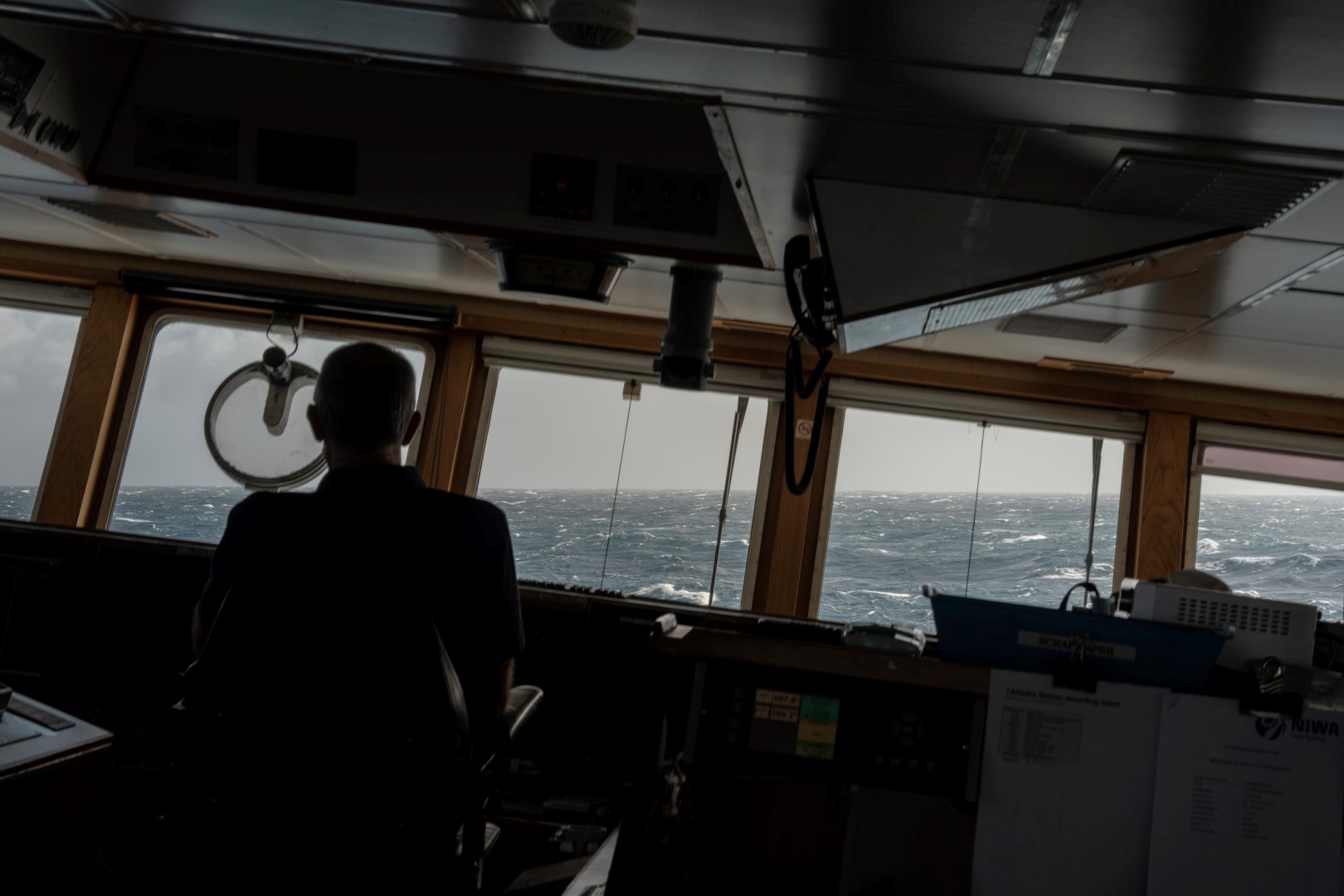
Battening down the hatches (21 February)
Short update today. Weather continues to be poor today with large swell (6-7 metre, occasional 8 metre) and up to 50 knot winds. Some handle the rough seas better than others, but it’s not pleasant. Wind easing in the evening, but still around 4 metre swell. Completed short section of TOPAZ line 1 and transited back to NCH3a. If we can do anything, our amazing crew will let us know.
Back to it (22 February)
In the early hours of the morning the weather calmed enough to get a couple of Van Veen grab samples at the NCH3a site. Only the first grab came up with a few scoops of sediment in it, the second grab came up empty. We managed to subsample some of this sediment for meiofauna. You can’t win them all.
We took a DTIS transect down a small ridge at the north of the NCH-3a site. Just off the peak we saw a large square boulder with some corals, anemone, hyocrinid (stalked crinoid) and glass sponges on it. Followed by a dense nodule field, with occasional xenophyophore and small fauna, which thinned out quickly, giving way to soft sediments until the end of transect. We saw a few rat tails, holothurians, ophiuroids and starfish.
Later that night we deployed a brenke sled to the last third of the DTIS transect targeting the soft sediment area. Both port and starboard winches needed to be spliced together to deploy more than 4000 m of wire to get the Brenke down to the seafloor. Our hats go off to our teams who continue to explore these depths which is challenging work.
Once the beam trawl is back on deck we will transit south to the SL-2 site. The weather has improved a lot now, with swell eased and wind dropped 10-20 knots. We plan for bad weather in the schedule, but over these days we have a lot of discussion about the weather and our plans to sample. We will continue to watch the weather and adapt.
Voyages like this don’t happen very often, so we all want to make hay while the sun shines.
“An excellent selection of deep sea fishes and invertebrates” (February 23)
In the early hours, we completed a beam trawl at the Non-Channel site NCH-3a, which got an excellent selection of deep sea fishes and invertebrates including some very rare basketwork eels, Histiobranchus bruuni, and some rattails, seaspiders, sea cucumbers including a large specimen of ‘the gummy squirrel’ sea cucumber (Psychropotes sp.), ophiuroids, a dumbo octopus (Grimpoteuthis (female with eggs) and some rare and interesting gastropods that might be new species. We think there may have been some small nodules present in the sample too.
We then headed to the Bounty slope site SL-2 (1500 m depth), which is a site pre-selected by Kerry Walton, since we know next to nothing about the fauna from this depth band along the slope here.
Multibeam transect lines were run over the slope site SL-2 on arrival and a DTIS was deployed on a slightly raised area of the multibeam map, indicating some kind of rugged feature. The DTIS camera transect ran slightly upslope. Small outcrops of bedrock and soft sediment were seen with larger patches with ripples and small pebbles. Extended flat areas of pebbles were dense in places. Few animals were seen on rocks, small stylasterids, gorgonians, hexactinellids, and few animals on soft sediments (tam ‘o’shanters, holothurians, rat tails. A rare ghost shark (Chimaera) was seen at the end of the video.
A sled was deployed after this and collected some stylasterids, black coral and sponges. A fossil shark tooth was also pulled from the catch, which Daniel Moore has identified as Cosmopolitodus hastalis – an ancestral white shark from the Miocene.
A second DTIS transect was run slightly uphill to look for flatter ground. The seafloor consisted of periods of sandy ripply sediment interrupted with sections of bedrock, boulders and cobbles with sandy overlay. Sponges and a few black corals were attached to rocks and the occasional holothurian and ophiuroid and some rattails and eels were seen.
Next we move to a new deeper abyssal site (C1) east of the slope where we hope to find the end of the Bounty channel and deploy more gear tomorrow. We weren’t sure if we would make it here with the weather, so nice to be able to explore it.

A lesson in exploring the deep (24 February)
Today the weather was much calmer and we made it to the abyssal C1 site. We are now over 500km away from the coastline of the South Island now, the furthest we will venture.
On arrival, we completed two hours of multibeaming to produce the site map of this area. There are plenty of people waiting back at NIWA who are going to be excited by this data. We found a section of channel, a small knoll and some muddy plains to sample in.
As always, we got our eyes down there via DTIS. This was the deepest DTIS deployment of our voyage. It lost communication with the vessel just as soon as it had reached the seafloor at 4670 m deep. Despite trying to restart the system, it could not be made to work, so it was decided to bring the camera back up on deck to see what the problem was. Once DTIS was up on deck, we immediately spotted the flattened camera cylinder. An implosion had completely crushed the video camera inside the titanium casing on the seafloor.
To say we were disheartened is an understatement, but operating at these depths is incredibly difficult. And we always bring spares. NIWA’s principal technician Steve George will now spend some time replacing parts from the spare DTIS onboard. We take our hats off to our amazing team who deal with each challenge as it arises. To think that we are learning more about the incredible animals who make this environment their homes, withstanding the kind of pressure that can pancake titanium. Fortunately, we only had two DTIS deployments in our programme today and very few left as the journey comes to a close.
Despite the setback, we knew where soft sediments where in the area, so the deployments could go ahead to the depths of over 4800 m. We chose some multicore targets and this evening got 3 long cores of mud on the first deployment (used for meiofauna, macrofauna and sediment properties) from a spot right next to the channel in 4800 m. The second multicorer at the same spot collected another 3 full cores (used for meiofauna, macrofauna and sediment properties).
There is a little bit of bad weather rolling past us from later tonight until late morning, but this should clear and leave us with fine weather for our last days of sampling and for our transit home.
“A really brilliant selection of fish and invertebrate samples” (February 25)
Early morning of Sunday the night shift completed two multicoring deployments in soft sediment behind a knoll next to the channel, returning 3 good long cores on the first deployment and 4 cores on the next drop.
Core samples do not offer the same instant results as the other deployments. That excitement comes later. The cores are preserved until we get back to shore, where we will start sorting through the samples and examining the specimens using microscopes. It highlights the excitement to come from the workshops when we get together with experts around the world to see what will be found in these samples.
The weather started to get rougher again during transit to NCH-3. On arrival, the crew deployed the beam trawl at a parallel transect to where we deployed the DTIS previously. The deployment takes about 4.5 hours from ship to seabed to ship deck again, but it was totally worth it! We got a really brilliant selection of fish and invertebrate samples including holothuroids, rattails, a rare abyssal cusk eel Aphyonidae, which was in excellent condition, several species of ophiuroids and a white shark tooth. There were two small specimens of an unusual new type of anemone or zoanthid-like creature with 6 arms and tentacles arranged down each arm. It seems very much like a single octocoral polyp, but the 6 arms indicate they might be in the ‘Hexacorallia’, a very exciting find! Kerry collected more of the undescribed seaslugs and more specimens of two new species of snail. Lots of photographs were taken, which will help with descriptions of the animals in future papers.
A Brenke sled deployment just before midnight collected small invertebrate samples for sorting back on land.
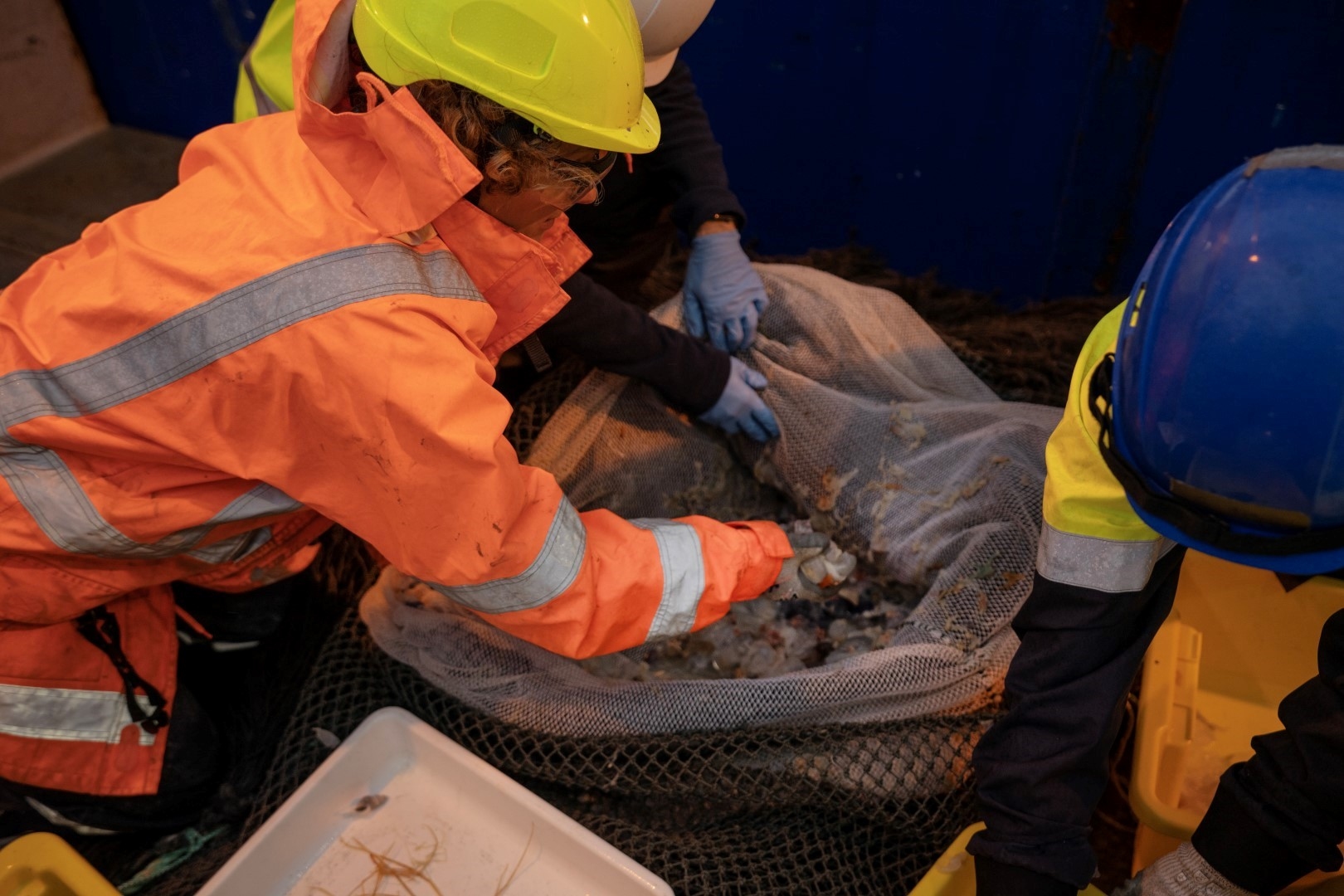
Last days (26 February)
Not all deployments work. A sled deployed only collected two ophiuroids and sponge (80 g catch) this morning. A plankton tow however, collected amphipods and a new brachioteuthid squid species!
We moved back to NCH-3a and deployed a seamount sled once again on a nodule site we saw but from a different transect cutting across the previous DTIS line where we saw a dense patch of nodules. The sled collected about 100kg of rock, clay and some nodules, which have been preserved in several different ways to later examine them for associated meiofauna, and for geology. A seamount sled was deployed at CH-3 last thing on Monday night, coming up in the early hours of Tuesday with some gravel and a few invertebrates and small myctophid fish. Now we begin a transit north to another site on the northern slope of the Bounty trough to deploy our last sampling gear.
Final deployments (27 February)
We completed our transit to the North Bounty Trough. The new OKTOPUS multicorer was made ready for deployment in a muddy site at 2555 m and brought back 8 short 11 cm cores. The team was happy with the debut performance and the NIWA team each had a go at processing the cores using the new rack and handling the new shuttles. Samples were processed for Macrofauna, meiofauna and sediment properties.
Following this we deployed a beam trawl down the multibeam track and collected lots of ophiuroids, holothuroids, molluscs, sea spiders, fish, isopods, two seapens and a large squat lobster. The fauna was very similar to that seen at a 3000 m site on the southern side of the trough.
This was the last deployment of our survey, so it was a nice way to end with a successful sample. Processing of the trawl continued through till about 10pm. Clean up starts tomorrow.
We are steamed back to Wellington via Mernoo Bank for arrival back to port on Thursday.
And there you have it. A 21-day voyage of around 4518 Kilometres. Over 1700 samples and a sample collected at 4808 m. A very happy (but tired) team.
We look forward to the next step of sorting, identifying and describing the finds at the workshop.
